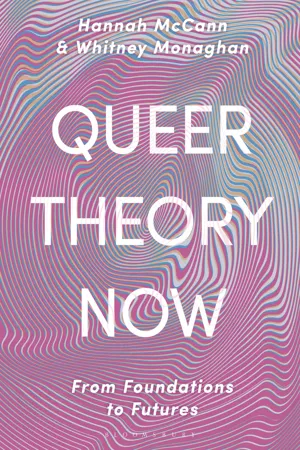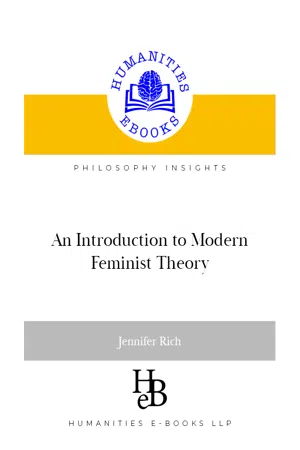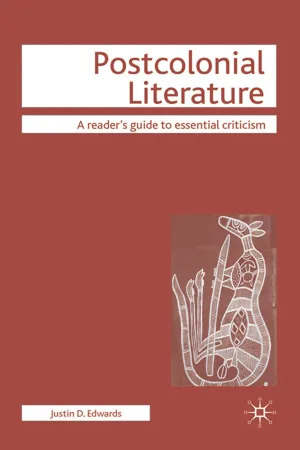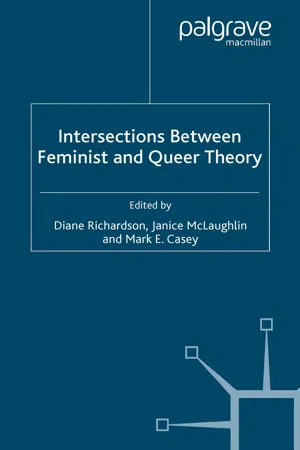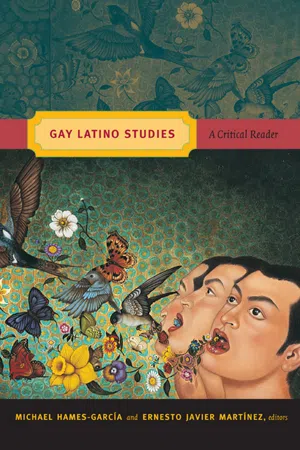Literature
Queer Theory
Queer Theory is a critical framework that challenges traditional notions of gender and sexuality. It seeks to deconstruct and analyze the social constructs that define and regulate these identities, as well as the power dynamics at play. In literature, Queer Theory is used to examine how LGBTQ+ themes and characters are represented and to explore the intersection of sexuality, gender, and identity.
Written by Perlego with AI-assistance
Related key terms
1 of 5
11 Key excerpts on "Queer Theory"
- eBook - PDF
Queer Theory Now
From Foundations to Futures
- Hannah McCann, Whitney Monaghan(Authors)
- 2019(Publication Date)
- Bloomsbury Academic(Publisher)
1 1 Defining Queer Theory KEY TERMS AND CONCEPTS queer, queering, genealogy, the gender binary, LGBTIQ, norms, normalisation, normative, normativity, heteronormativity, anti-normativity, postqueer DEFINING THE INDEFINABLE How can theory be “queer”? What is the difference between queer identity, queer politics and Queer Theory? Is Queer Theory always related to sexuality in some way? The aim of this book is to help make sense of these questions by tracing Queer Theory across a range of historical contexts. As we find, though queer identity, politics and theory can be understood to offer separate and often conflicting approaches, a historical lens helps us understand how these tensions have come to be. We find that we cannot understand what queer the-ory “now” is, without looking backward, and at times, rethinking a few grand narratives. It is often said that Queer Theory is difficult to define, or that it is anti-thetical to the spirit of the theory to tie it down to a single meaning. As we will see throughout this book, queer is a “deliberately ambiguous term” that is simultaneously a way of naming, describing, doing and being (Monaghan 2016 , 7). This is where Queer Theory finds its radical potential as a term to challenge, interrogate, destabilise and subvert, but it also means there is diffi-culty in pinpointing Queer Theory’s meaning. As Annamarie Jagose notes, it is “a concept that prominently insists on the radical unknowability of its future formations,” that maintains a “strategically open-ended relational character” (2009, 158). Or, as Donald Hall has argued, we must understand Queer Theory in the plural: “there is no ‘Queer Theory’ in the singular, only many different voices and sometimes overlapping, sometimes divergent perspectives that can be loosely called ‘queer theories’” (2003, 5). Queer Theory is, it seems, mercu-rial (Dilley 1999 ). - eBook - PDF
- Jennifer Rich(Author)
- 2021(Publication Date)
- Humanities E-Books(Publisher)
Queer Theory Queer Theory expands the parameters of feminist theory by centralizing sexuality in the analysis of gender oppression. Inspired by Adrienne Rich’s seminal article ‘Compulsory Heterosexuality and the Lesbian Existence’, discussed below, this political/theoretical movement critiqued traditional feminist critiques’ marginalization of the issue of sexuality in its analysis of patriarchal culture. Queer Theory is also anticipated by Monique Wittig’s work, but its main concern is not only to discuss the experience of lesbians within a male-defined paradigm of gender, but to question the very foundations of our notions of sexuality and normativity—especially with regard to heterosexuality. Judith Butler, a prominent practitioner of Queer Theory, describes this approach as a form of ‘trouble-making’; Queer Theory attempts to question, to disturb, to trouble identity categories (man, woman, gay, straight, lesbian, queer, transgender, and so on) and to investigate the ‘political stakes’ in naturalizing categories which are not at all natural, but rather the result (‘effects’) of certain institutional and personal power relationships. As she writes, ‘the task of this inquiry [Queer Theory] is to centre on—and decentre—such defining institutions: phallologocentrism and compulsory heterosexuality’ (Butler, Gender Trouble, ix). Queer Theory—in its practice—is more theoretical than political, but its inquiries nevertheless lead to political activism. 1 Having established the theoretical bias of Queer Theory, it is never-theless important to note its origins have a definite political base— particularly the New York Stonewall riots of 1969. These riots gave impetus toward forming a rejuvenated and radicalized gay rights agenda, and resulted in the creation of many politically-oriented 1 ‘Queer Nation’ was one political group that resulted, in part, from the theoretical work in Queer Theory. - eBook - PDF
- Justin D. Edwards(Author)
- 2008(Publication Date)
- Red Globe Press(Publisher)
CHAPTER TEN Queer O ver the past 15 years or so a mode of cultural criticism known as Queer Theory has gained influence as a perspective that investi- gates existing categories of sex, gender and sexual desire. Specifically, Queer Theory highlights ways of thinking about fixed sexual identities like heterosexual and homosexual and essentialist notions of sexuality and genders within Western cultures. As a result, in the words of Peter Brooker, ‘Queer Theory is not […] a separatist movement claiming an essence of gayness. Rather, it emphasizes the constructedness, plurality and ambivalence of sexual identities’. 1 In Postcolonial, Queer: Theoretical Intersections (2001), editor John C. Hawley suggests that the postcolonial issues of race, nationalism and gender intersect with Queer Theory on questions of power, oppression and hierarchical relations. In this, Hawley raises important queries about queer subjectivity, as well as the limits and strengths of Queer Theory, to inform an understanding of same-sex desire, sexuality and sexual expression within a postcolonial context. Queer Theory can, Hawley proposes, expand theoretically into the realm of postcolonial studies in order to be more comprehensive in its approach to sexuality. A queer approach can avoid colonizing impulses and begin to unite with postcolonialism to inform a broader discussion about sexualities around the globe. ‘Some queer theorists’, Hawley writes, ‘at times find themselves resistant to the seemingly deeply ingrained homophobia of much postcolonial culture and discourse; many of those in postcolo- nial studies decry gay/lesbian studies as “white” and “elitist”.’ 2 Hawley addresses this binarism and identifies the division between these theo- retical approaches as limiting, false and mutually destructive. For Hawley, then, postcolonialism can inform Queer Theory and thus challenge limited forms of sexual identity politics. - eBook - PDF
Constructing Sexualities and Gendered Bodies in School Spaces
Nordic Insights on Queer and Transgender Students
- Jón Ingvar Kjaran(Author)
- 2017(Publication Date)
- Palgrave Macmillan(Publisher)
J.I. KJARAN 17 Queer Theory: THE INTERSECTION OF GENDER AND SEXUALITY De Lauretis first coined the term “Queer Theory” in the 1990s, which marked a shift from lesbian and gay studies to queer studies, often referred to as the “queer turn” in research on sexualities and gender identities. 21 She, however, abandoned the term shortly afterwards, on the grounds that it had been institutionalized and taken over by the mainstream discourse. 22 Nevertheless, Queer Theory still has, in my view, much potential to be both radical and critical. I therefore rely upon some aspects of Queer Theory in my work. Its critical approach I find helpful to analyze and to place a criti- cal light upon the underlying structures of oppression within schools. The queer theorist and historian Halperin argues that “[queer] … demarcates not a positivity, but a positionality vis-à-vis the normative”. 23 Accordingly, Queer Theory as a position questions the discourse of normalcy and institu- tions of society. It also emphasizes the social-constructionist and discursive formation of sexualities, gender and other identity categories. 24 In this respect, Queer Theory draws on Foucault who has emphasized the discur- sive formation of the sexual subject through history. 25 In the first volume of The History of Sexuality, he described the discursive construction of the modern homosexual subject in Western culture. According to Foucault, the homosexual subject was constructed and labeled through nineteenth- century medical discourse, a product of modern systems of knowledge and power. This understanding disrupted the previously dominant discourse of nature-versus-nurture debate and marked a political breakthrough for the lesbian and gay movement in the latter part of the twentieth century. 26 Butler’s works have also contributed considerably to Queer Theory. - eBook - PDF
- Mary Klages(Author)
- 2006(Publication Date)
- Continuum(Publisher)
As the prevalence of the structure of the binary opposition tells us, once you set up a category labeled ‘normal,’ you automatically set up its opposite, a category labeled ‘deviant,’ and the specific acts or identities which fill those cat-egories then get linked to other forms of social practices and methods of social control. When you do something your culture labels deviant, you are liable to be punished for it: by being arrested, by being shamed, made to feel dirty, by losing your job, your license, your loved ones, your self-respect, your health insurance. Gay/lesbian studies, LITERARY THEORY: A GUIDE FOR THE PERPLEXED 116 like feminist studies, works to understand how these categories of normal and deviant are constructed, how they operate, how they are enforced, in order to intervene into changing or ending them. Which brings me – finally – to Queer Theory. Queer Theory emerges from gay/lesbian studies’ attention to the social construction of categories of normative and deviant sexual behavior. But while gay/lesbian studies, as the name implies, focused largely on questions of homosexuality, Queer Theory expands its realm of investigation. Queer Theory looks at, and studies, and has a political critique of, anything that falls into normative and deviant categories, particu-larly sexual activities and identities. The word ‘queer,’ as it appears in the dictionary, has a primary meaning of ‘odd,’ ‘peculiar,’ ‘out of the ordinary.’ Queer Theory concerns itself with any and all forms of sexuality that are ‘queer’ in this sense – and then, by extension, with the normative behaviors and identities which define what is ‘queer’ (by being their binary opposites). Thus Queer Theory expands the scope of its analysis to all kinds of behaviors, including those which are gender-bending as well as those which involve ‘queer’ non-normative forms of sexuality. - D. Richardson, J. McLaughlin, M. Casey, D. Richardson, J. McLaughlin, M. Casey(Authors)
- 2006(Publication Date)
- Palgrave Macmillan(Publisher)
One possible explanation for why there has been little systematic analysis of this relationship in the literature, is that in its theoretical approach queer resists definition and is characterised by indeterminacy, as Halperin remarks: ‘There is nothing in particular to which it necessarily 19 refers’ (Halperin, 1995: 62 original emphasis). Along with other queer writers such as Warner (1993), Halperin offers a definition of queer as a positionality ‘vis-a-vis the normative’. Queer, he argues, is by definition ‘whatever is at odds with the normal, the legitimate, the dominant’ (Halperin, 1995: 62). This suggests that queer can be deployed in many different ways and in relation to any number of different areas. If we are to understand Queer Theory in this way as a fluid, mobile, non specific zone of enquiry that is resistant to being ‘fixed’, attempts to locate it in relation to other theoretical perspectives, in this case feminism, might seem likely to be beset with difficulty. This said I would argue that, as McKee puts it: ‘Queer is not an entirely empty signifier …’ (McKee, 1999: 237). It does have meanings and positional claims that are shared and recognised. That is to say, despite being constructed in terms of ‘vagueness’, it is possible to iden- tify patterns in how Queer Theory is practised in terms of what it theo- rises, the theoretical paradigms it deploys, and the disciplinary traditions where Queer Theory is most apparent. It is important that we acknowledge this in order to understand how queer shapes ‘how and why particular knowledges, practices, identities, and texts are validated at the expense of others’ (Sullivan, 2003: 47), more especially in con- texts where queer ideas appear hegemonic. This point is pertinent to one of the aims of this chapter, which is to consider how queer impacts on feminist thought and practice, in particular through the construc- tion of the theoretical investigation of sexuality as the ‘proper’ domain of queer studies.- eBook - PDF
Beyond Borders
Queer Eros and Ethos (Ethics) in LGBTQ Young Adult Literature
- Darla Linville, David Lee Carlson(Authors)
- 2016(Publication Date)
As YAL has come to em- brace LGBTQ themes, it has done so largely through contemporary realism and the narrative structure of coming-of-age. If contemporary realistic YAL is problematic in forwarding normative beliefs about adolescence, growth, and coming-of-age in general, it is particularly trou- blesome in depicting what coming-of-age might mean for youth who identify as LGBTQ. Queer Theory helps us illuminate the problematics of the coming-out narrative when it is interwoven with the coming-of-age narrative in YAL. In Queer Theory, gender, sex, and sexuality are regarded as unstable, temporal categories that shift over time, across social and cultural contexts, and in response OUT OF THE CLOSET AND ALL GROWN UP | 7 to society’s shifting perceptions on sexuality (and gender, and sex) (Butler, 2004; Marcus, 2005). Queer Theory does not assume a natural link between a person’s gender and their sexual identity or practice (Butler, 2004). While feminist theory highlighted the distinction between one’s assigned (or biological) sex and one’s gender, Queer Theory disconnects sexuality from both, thereby undermining and blurring binary categories of heterosexual/homosexual, male/female, and masculine/feminine (Marcus, 2005; Sykes, 2011). An unstable sexual identity, then, does not indicate a jumping back and forth within the binary of “straight” and “gay.” Instead, sexual desire is based on a host of factors, including context, interaction, preference, etc., which result in many possible (and sometimes conflicting) sexualities. Consistent with the tenets of Queer Theory, several scholars have pinpointed ways in which LGBTQ YAL sometimes works to maintain limited and binary conceptions of sexuality and gender. - eBook - PDF
Gay Latino Studies
A Critical Reader
- Michael Hames-García, Ernesto Javier Martínez, Michael Hames-García, Ernesto Javier Martínez(Authors)
- 2011(Publication Date)
- Duke University Press Books(Publisher)
Certainly very little in Queer Theory has sought to answer such questions as effectively or with as much political conviction as some older works by feminists that queer theorists so often define themselves against. Given Queer Theory’s promise to integrate race, sexuality, gender, and class, how have texts that do not fulfill that promise emerged as the field’s clas-sics? How do Queer Theory and lesbian and gay studies answer their discontents, those of us who signed on to their projects in the late 1980s and early 1990s, spending student budgets on Routledge books and GLQ only to find ourselves eventually (re)turning elsewhere for answers? And finally, what might an alter-native to Queer Theory as it has come to be known in the U.S. academy look like? In this essay I explore the construction of the dominant self-narratives of Queer Theory Revisited 21 Queer Theory (queer genealogies) and some of their consequences. I then offer an alternative genealogy for critical thinking about sexuality in the United States, one that highlights the early emergence of intersectional thinking. This account is followed by an extended discussion of how some seminal texts in Queer Theory from the 1990s address (or fail to address) race, noting a con-sistent pattern of erasure, marginalization, and tokenization. I then explore a central claim to theoretical innovation within Queer Theory: the claim that the category of queer enables critique and transgression of boundaries, identities, and subject positions. Questioning some of the assumptions in this claim, I argue that it constitutes a form of ontological denial that enables Queer Theory to mask its own dependence on an unacknowledged white racial identity. The conclusion considers recent directions taken by activist-scholars who address the interrelations among race, gender, and sexuality. These include scholars who identify (often ambivalently) with Queer Theory and scholars who distance themselves from it. - eBook - PDF
Feminist Social and Political Theory
Contemporary Debates and Dialogues
- Janice McLaughlin(Author)
- 2017(Publication Date)
- Red Globe Press(Publisher)
Other forms of sexuality and intimacy appear as freakish deviants, towards which straight society may show a certain level of voyeurism (hence the appeal of true-life sex confessional programmes in both the UK and the USA). Such figures are the contemporary exotic other who helps secure just 140 Feminist social and political theory how normal everyone else is, or thinks they are. Queer writings are thus concerned with the role the ‘homosexual other’ as a symbolic figure plays in maintaining heteronormativity in Western society. Rosemary Hennessy describes heteronormativity as ‘an institution that organizes more than just the sexual: it is socially pervasive, underlying myriad taken-for-granted norms that shape what can be seen, said, and valued’ (1995: 146). Queer approaches can be summarized as pursuing the following claims: ● Both heterosexuality and homosexuality are social constructions. ● The binary opposition between the two is an important source of mean-ing and identity. ● The dominant legitimate identity requires the existence of the deviant category to make sense. ● The dominance of heterosexuality is fragile and produces the means for its decline. ● Transgression offers scope for resistance and challenge. Queer critique of feminism The tensions between women and men in the lesbian and gay movement in the 1970s led some lesbians to look to radical feminism as an explanatory framework, community and platform for activism (Jeffreys, 1994). Within this framework sexuality is viewed as a product and tool of patriarchy, and lesbianism is seen as a political choice as much as a sexual desire. At least implicit in this argument is a belief that feminism, in particular radical feminism, is the key site for exploring the operation of sexuality and its role in oppressing women (Rubin, 1975). Queer writers, including those who identify as feminist, have consciously set out to challenge and reject radical feminism’s arguments (Bright, 1984; Califia, 1981). - eBook - PDF
The Making and Unmaking of Differences
Anthropological, Sociological and Philosophical Perspectives
- Richard Rottenburg, Burkhard Schnepel, Shingo Shimada, Richard Rottenburg, Burkhard Schnepel, Shingo Shimada(Authors)
- 2015(Publication Date)
- transcript Verlag(Publisher)
From the theoretical viewpoint, the engagement of Queer theorists in dif-ferences leads surely to admit that actually “there is no ‘Queer Theory’ in the singular, only many different voices and sometimes overlapping, sometime divergent perspectives that can be loosely called ‘queer theories’” (Hall 2003: 5; see also e.g. Jagose 1996; Turner 2000; Sullivan 2003). Thus, it can be sta-ted that the main purpose of Queer theories is the attempt to literally “queer”—to make it “strange” or “odd”—the way we usually construct theo-ries, and the “knowledge” we assumedly acquire from them, in a fashion very similar to Nietzschean perspectivism: refusing the possibility to find the truth about sexuality and gender, and affirming instead the need “for continued dis-cussion, for diversity in perspective and articulation, and for challenging and disruptive speech, even that which challenges and disrupts queer claims them-selves” (Hall 2003: 6). So what might “identify” Queer theories as a research field is precisely their interdisciplinary and difficult-to-conceptualize character, in the sense of what Deleuze and Guattari (1987) have called the logic of rhizomatics as op-posed to the traditional logic of arborescence typical of Western thought. The metaphor of arborescence is the tree and its logic is based on the belief that there is an essential truth and meaning springing from its invisible roots . The-refore “everything in a tree system relies for its value on the meaning of other elements in the structure”, but “this value is inevitably distributed into a hierarchy, which subordinates the value of an entity to another, regardless of the function of that entity in any given relationship or situation ” (Mansfield 2000: 141). - eBook - PDF
- J.L. Mey(Author)
- 2009(Publication Date)
- Elsevier Science(Publisher)
Thus, ‘queer’ in-cludes (but is not restricted to) all sexual and gender minorities. In this usage, the actual membership in a ‘queer’ community is left intentionally vague because ‘queer’ is defined not in terms of who belongs but in terms of what queers react against. Thus, the common denominator for queers is their marginalization and exclusion rather than being unified by some common identity or shared social practices. The ‘queering’ of academic disciplines was proposed as a means of turning attention toward those individuals who had been traditionally marginalized in social theory. By focusing on individuals who are not prototypi-cal members of traditional (etic) identity cate-gories, Queer Theory attempts to gain insight into the normative forces that underlie social practice. Research that falls within the realm of queer linguis-tics does not always deal with speakers who are gay, lesbian, or transgendered but may deal with speakers who are marginalized in other ways, as with Mary Bucholtz’s (1999) research on the language of self-proclaimed ‘nerds.’ Within linguistics, this use of ‘queer’ has been adopted by those working in ‘queer linguistics’ (Barrett, 1997, 2002; Bucholtz and Hall, 2003, 2004; Hall, 2003; Livia and Hall, 1997a) in an attempt to adopt and amend proposals from Queer Theory into a frame-work for the study of language. Although ‘queer’ with-in queer linguistics was intended to refer to Queer Theory (rather than any community of actual queers), this use of ‘queer’ has been criticized primarily on the grounds that it does not refer to any externally definable social group (Kulick, 2000; Leap, 2002). In contrast to so-ciolinguistic frameworks focusing on norms of lan-guage variation that categorize individuals into speech communities based on etic identity categories, queer linguistics assumes that speech communities are prototype categories that do not have clearly definable boundaries.
Index pages curate the most relevant extracts from our library of academic textbooks. They’ve been created using an in-house natural language model (NLM), each adding context and meaning to key research topics.
